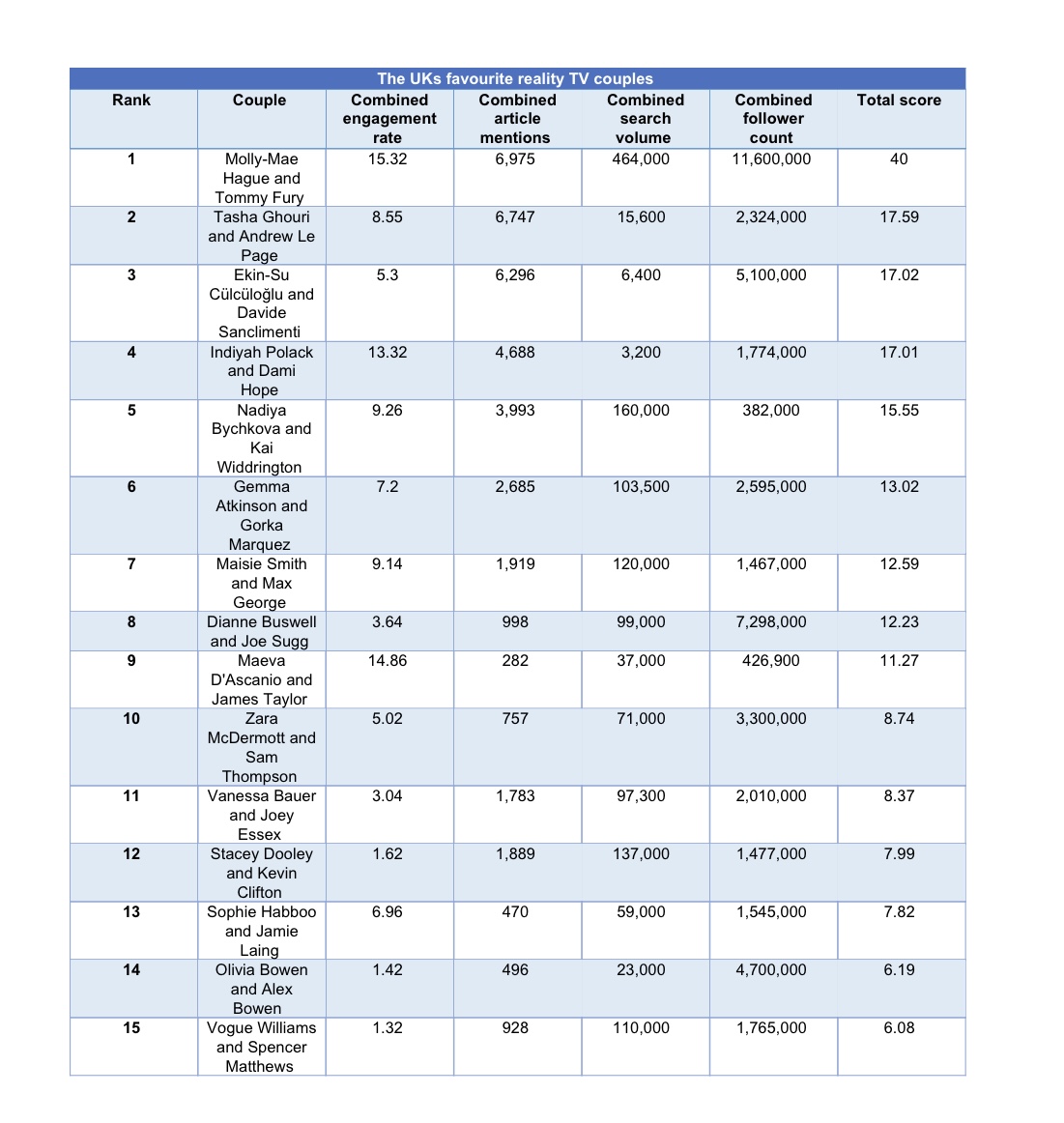The UK’s favourite reality TV couples

New research reveals the UK’s favourite reality TV couples, with Molly-Mae and Tommy taking the top spot.
The research, conducted by online casino experts Online.Casino examined every couple that met or featured together on a UK reality TV show together based on several factors: each couple’s combined Instagram following, combined Instagram engagement rate, search volume by couple and online article mentions in the last year by couple. These factors were combined to discover the UK’s favourite reality TV couples.
The research revealed that Molly-Mae Hague and Tommy Fury are the UK’s favourite reality TV couple. The couple finished in second place on Love Island in 2019 and have since become one of the most popular and recognisable couples in the UK. They have also recently welcomed their first child together, a daughter named Bambi. The couple dominate the ranking, placing first in every four factors analysed. For instance, the couple have the highest number of combined Instagram followers, with 11.6 million, and are the most Googled reality TV couple in the UK, receiving 464,000 average searches a month.
Surprisingly, Tasha Ghouri and Andrew Le Page rank as the UK’s second favourite reality TV couple. Since meeting on last year’s Love Island, the couple’s relationship has gone from strength to strength, and they now have 2.3 million combined Instagram followers. Interestingly, Tasha and Andrew follow closely behind Molly-Mae and Tommy, with the second-highest number of article mentions in the last year, with 6,747 online mentions.
Last year’s Love Island winners Ekin-Su Cülcüloğlu and Davide Sanclimenti rank as the UK’s third favourite couple from reality TV. The fan-favourite couple rank as the UK’s third most popular reality TV couple on Instagram, with a combined follower count of 5.1 million. When broken down, Davide has 1.9 million followers, while Ekin-Su boasts 3.2 million.
Indiyah Polack and Dami Hope are the UK’s fourth favourite reality TV couple. Indiyah and Dami are another Love Island couple loved by the public, who came third on last year’s series. The couple have the third highest combined engagement rate, with 13.32%, and have had 4,688 online article mentions in the last year, the fourth highest in the ranking.
The research revealed that professional dancers Nadiya Bychkova and Kai Widdrington rank in fifth place. The Strictly couple, who met on the dancing show, have been dating since 2021 and rank as the UK’s favourite couple from Strictly Come Dancing. The couple are also the second most Googled reality TV couple in the UK, receiving 160,000 average monthly searches between them.
Gemma Atkinson and Gorka Marquez rank as the UK’s sixth favourite reality TV couple. The Hollyoaks actress met her now-husband and professional dancer while competing on Strictly Come Dancing and is now pregnant with the couple’s second child. The couple have a combined Instagram following of 2.5 million and received 2,685 online article mentions in the last year, a high number of mentions despite meeting back in 2017.
Two more Strictly Come Dancing couples rank in seventh and eighth place. Maisie Smith and Max George are the UK’s seventh favourite reality TV couple. EastEnders actress Maisie and The Wanted’s Max met on the set of Strictly in 2020 and announced their relationship one year later. In eighth place are Dianne Buswell and Joe Sugg. YouTuber Joe and Strictly’s professional dancer Dianne were paired together in 2018 and have been together ever since. The couple have the second-highest combined follower count in the ranking, with 7.2 million followers.
Rounding out the top ten are two couples from Made in Chelsea. In ninth place are Maeva D’Ascanio and James Taylor, who have the second-highest combined engagement rate in the ranking, with 14.86%. Zara McDermott and Sam Thompson rank tenth and have the fifth-highest number of Instagram followers between them, with 3.3 million.
Joey Essex and Vanessa Bauer place just outside of the top ten. Although the couple have not confirmed their relationship, the Dancing On Ice couple have sparked relationship rumours since the beginning of this year’s series and are the newest potential couple to feature in the ranking.
A spokesperson for Online.Casino commented on the findings: “Whether it’s a dating show like Love Island or a competition such as Dancing On Ice, reality TV shows have seen romance blossom between plenty of celebrities, and these relationships continue to captivate audiences.
These findings highlight the undeniable popularity and success of Love Island, with one-third of the UK’s top 15 favourite couples having found love on the Island. Not only do newer couples from the show feature in the ranking, but also couples from older seasons too that are still going strong, like Molly-Mae and Tommy and fan-favourites Olivia and Alex Bowen.”






